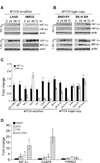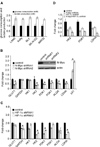Combinatorial regulation of neuroblastoma tumor progression by N-Myc and hypoxia inducible factor HIF-1alpha
- PMID: 20961996
- PMCID: PMC3005134
- DOI: 10.1158/0008-5472.CAN-10-0740
Combinatorial regulation of neuroblastoma tumor progression by N-Myc and hypoxia inducible factor HIF-1alpha
Abstract
In human neuroblastoma, amplification of the MYCN gene predicts poor prognosis and resistance to therapy. Because hypoxia contributes to aggressive tumor phenotypes, predominantly via two structurally related hypoxia inducible factors, HIF-1α and HIF-2α, we examined hypoxia responses in MYCN-amplified neuroblastoma cells. We demonstrate here that HIF-1α, but not HIF-2α, is preferentially expressed in both MYCN-amplified neuroblastoma cells and primary tumors in comparison to samples without MYCN amplification. Our results showed that interplay between N-Myc and HIF-1α plays critical roles in neuroblastoma. For example, high levels of N-Myc override HIF-1α inhibition of cell cycle progression, enabling continued proliferation under hypoxia. Furthermore, both HIF-1α and N-Myc are essential for the Warburg effect (aerobic glycolysis) in neuroblastomas by activating the transcription of multiple glycolytic genes. Of note, expressions of Phosphoglycerate Kinase 1 (PGK1), Hexokinase 2 (HK2), and Lactate Dehydrogenase A (LDHA) were each significantly higher in MYCN-amplified neuroblastomas than in tumors without MYCN amplification. Interestingly, MYCN-amplified neuroblastoma cells are "addicted" to LDHA enzymatic activity, as its depletion completely inhibits tumorigenesis in vivo. Thus, our results provide mechanistic insights explaining how MYCN-amplified neuroblastoma cells contend with hypoxic stress and paradoxically how hypoxia contributes to neuroblastoma aggressiveness through combinatorial effects of N-Myc and HIF-1α. These results also suggest that LDHA represents a novel, pharmacologically tractable target for neuroblastoma therapeutics.
©2010 AACR.
Conflict of interest statement
The authors declared no potential conflicts of interest.
Figures






References
-
- Maris JM, Hogarty MD, Bagatell R, Cohn SL. Neuroblastoma. Lancet. 2007;369:2106–2120. - PubMed
Publication types
MeSH terms
Substances
Grants and funding
LinkOut - more resources
Full Text Sources
Other Literature Sources
Medical
Miscellaneous

